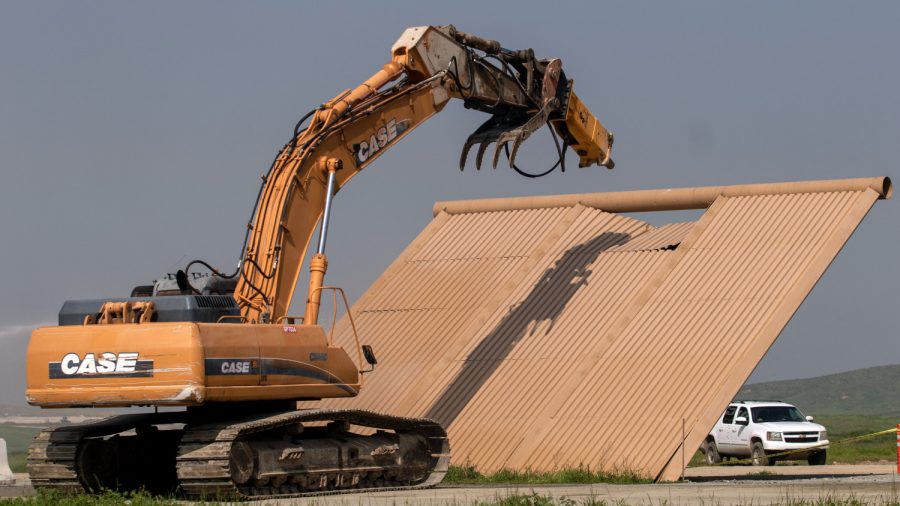SAN DIEGO—The U.S. government demolished the eight border wall prototypes on Feb. 27 to make way for the construction of a new 30-foot secondary wall between San Diego and Tijuana, Mexico.
The Trump administration says that as the elements of the prototypes that President Donald Trump visited last year have been melded into the current border fence designs, they have now served their purpose.
“They were initially built in 2017 to test the different types of walls,” Border Patrol spokesman Fabian Carbajal said, adding that suitable aspects would now be integrated into new primary and secondary walls.
President Donald Trump visited the location to see the installations of the four concrete and four steel panels firsthand. The prototypes were spaced closely together steps from an existing barrier between San Diego and Tijuana, Mexico.

Carbajal noted the plan was never to choose one of the prototypes but to test each of them.
“It was a misconception that one single wall was going to get chosen. So, from the eight prototypes, we were able to test them and … get all the positives from the walls.”
“We were able to get SWAT teams and our BORTAC Units to try to climb over the wall. We also had a different site where we had a 10-foot version of these walls where they try to see if they were able to drill through the walls.”
Elements of the prototypes have been melded into the current border fence design that will stretch along 14 miles of border starting from the Pacific Ocean.
Their removal makes way for the new secondary wall, that will be built with steel bollards, similar to slats, topped by a metal plate rising 30 feet from the ground—the same design being used elsewhere on the border. The new barrier vaguely resembles some of the steel prototypes but looks nothing like the solid concrete panels, which were widely panned as border agents couldn’t see what was happening on the other side.

The prototypes came down the same week that the House voted to block Trump’s national emergency declaration.
The eight prototypes, which cost $300,000 to $500,000 each to build, varied by slope, thickness, and curves. Bidding guidelines called from them to withstand at least an hour of punishment from a sledgehammer, pickaxe, torch, chisel, or battery-operated tools, and to prevent the use of climbing aids such as grappling hooks.
The guidelines also required that they be “aesthetically pleasing” from the U.S. side. One design had two shades of blue with white trim, while others were gray, tan, or brown—in sync with the desert.

The government rigorously tested the designs and, according to a summary from the Government Accountability Office, found that the concrete walls posed “extensive” construction challenges, while the others posed “substantial” or “moderate” challenges. Six of the eight would require extensive changes to accommodate drainage.
Border Patrol spokesman Ross Wilkin said testing also exposed several design flaws. A steel model with vertical U-shaped indentations could be jammed with small pieces of wood that could be climbed like a ladder. Prototypes with any exposed fasteners—like screws or bolts—could be broken with the right tools.
Wilkin noted that authorities never claimed the prototypes would be impenetrable and that they simply wanted to know how much time it took to crack each one.
The appeal to private industry for ideas was a new approach take to the building of barriers and provided many lessons to guide the border wall construction, he said. That includes learning that certain materials were unsuitable for quick repairs and that combining different surfaces, like bollards topped by plates, were more effective.

The new secondary wall will replace a steel-mesh fence that runs more than 12 miles from the Pacific Ocean. It worked like a fortress when it was built a decade ago but is now regularly breached with powerful battery-operated saws recently made available in home improvement stores. The new 30-foot wall will then extend another mile and a half over the prototype site. SLSCO Ltd. of Galveston, Texas, won the $101 million contract in December and started work last week.
Work is also underway to replace the first-layer barrier, which was a short fence. The new primary wall, also built with steel bollards and metal plates up to 30 feet high, runs the same length as the secondary wall and is nearly finished.
Illegal crossings in San Diego have fallen dramatically since barriers were installed in the 1990s and mid-2000s but Border Patrol Agent Theron Francisco said they are still regularly breached.

“With our old landing mat style fencing, they could jump that fence and cut our secondary fence that’s getting replaced in about a minute and a half. And that was happening quite a bit,” Francisco told NTD News on Feb. 22. “Now that we have new infrastructure and a higher primary wall and an even higher secondary wall that’s being built, that won’t happen anymore.
“It won’t be possible for them to get through in a minute to two minutes. It will take much longer.”
Francisco said that border patrol would like to see the southwest border implement the same system the San Diego sector in order to more effectively control the border.
“What we hope to see is just the border infrastructure throughout the southwest border to cover the entire approximate 2,000 miles—a primary wall, a secondary wall, an all-weather-road, technology, [and] lighting in between.”
NTD News reporter Kimberly Hayek contributed to this report.

